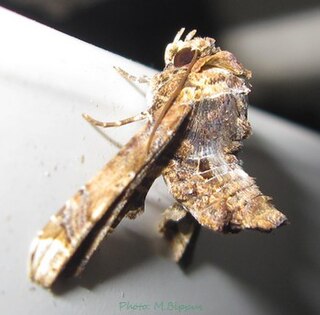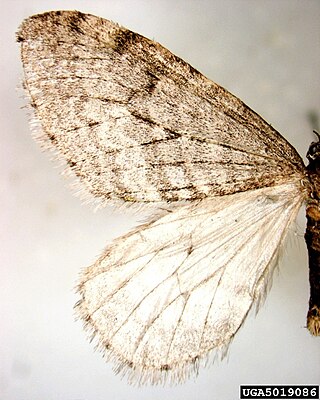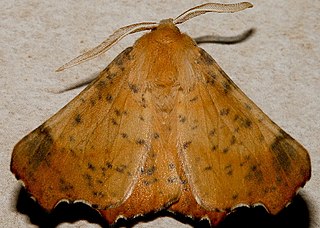
The desert rain frog, web-footed rain frog, or Boulenger's short-headed frog is a species of frog in the family Brevicipitidae. It is found in Namibia and South Africa. Its natural habitat is the narrow strip of sandy shores between the sea and the sand dunes. This area is characteristic of loose sand and continuous strong winds, with approximately 60mm of annual precipitation and no surface water. It is threatened by habitat loss by such factors as mining and tourism.

Eutelia is a genus of moths of the family Euteliidae erected by Jacob Hübner in 1823.
Lycimna is a monotypic moth genus of the family Erebidae. Its only species, Lycimna polymesata, is found in the north-eastern Himalayas, Borneo, Sumatra and Java. Both the genus and the species were first described by Francis Walker in 1860.
Nolasena is a monotypic moth genus of the family Erebidae. Its only species, Nolasena ferrifervens, is found in India, Sri Lanka, Borneo and the Philippines. Both the genus and species were first described by Francis Walker in 1858.

Epimecis is a genus of moths in the family Geometridae first described by Jacob Hübner in 1825.

Fascellina is a genus of moths in the family Geometridae described by Francis Walker in 1860.

Lycia is a genus of moths in the family Geometridae.

Nearcha is a genus of moths in the family Geometridae described by Edward Guest in 1887. All species in the genus are known from Australia.

Apamea commoda, the southern Quaker, is a moth of the family Noctuidae. The species was first described by Francis Walker in 1857. It is native to North America, where it is distributed from Nova Scotia west across southern Canada to southern British Columbia, north to Alaska and Yukon Territory, and south at least into Manitoba.

Hypena edictalis, the large bomolocha, is a moth of the family Erebidae. The species was first described by Francis Walker in 1859. It is found in North America from Quebec and Maine south to Virginia and Kentucky, west to the foothills of Alberta and the Peace River area of British Columbia.

Hypena palparia, the variegated snout-moth or mottled bomolocha, is a moth of the family Erebidae. The species was first described by Francis Walker in 1861. It is found in North America from Nova Scotia west across southern Canada to British Columbia, and south to Alabama and Texas.

Operophtera bruceata, the Bruce spanworm, hunter's moth, or native winter moth is a moth of the family Geometridae. The species was first described by George Duryea Hulst in 1886. It is found from coast to coast in southern Canada and the northern parts of the United States.

Nematocampa resistaria, the filament bearer, bordered thorn or horned spanworm moth, is a moth of the family Geometridae. The species was first described by Gottlieb August Wilhelm Herrich-Schäffer in 1856. It is found in North America from British Columbia to Nova Scotia, south to Florida and California.

Fishia illocata, the wandering brocade, is a moth of the family Noctuidae. The species was first described by Francis Walker in 1857. It is found from coast to coast in North America. It is abundant in the wet coastal forests and in wet conifer forests of the northern Rocky Mountains.

Melanolophia imitata, the western carpet or green-striped forest looper, is a moth of the family Geometridae. The species was first described by Francis Walker in 1860. It is found in western North America from southern California, north to Alaska and east to extreme south-western Alberta.

Macaria loricaria, the false Bruce spanworm or Eversmann's peacock, is a moth of the family Geometridae. It is found from Fennoscandia and the Baltic states to Sakhalin. It is also found in North America, where it is found from Alaska to Newfoundland and New York, south to Colorado.

Ennomos subsignaria, the elm spanworm moth, is a moth of the family Geometridae. The species was first described by Jacob Hübner in 1823. It is found in North America from Texas (south) to Alberta (northwest) and east to the Atlantic coast. It is recorded infrequently in Great Britain through accidental importation in asparagus.

Furcula cinerea, the gray furcula moth, is a species of moth in the family Notodontidae. It was first described by Francis Walker in 1865. It is found in the United States, southern Canada and the Northwest Territories.

Ennomos magnaria, the maple spanworm moth, notched wing moth, notched-wing geometer or notch-wing moth, is a moth of the family Geometridae. The species was first described by Achille Guenée in 1858. It is found from coast to coast in southern Canada and the northern United States, south in the east to Florida and Louisiana and in the west to California.

Oxydia vesulia, the spurge spanworm moth, is a species of geometrid moth in the family Geometridae. It is found in the Caribbean Sea, Central America, North America, and South America.

















